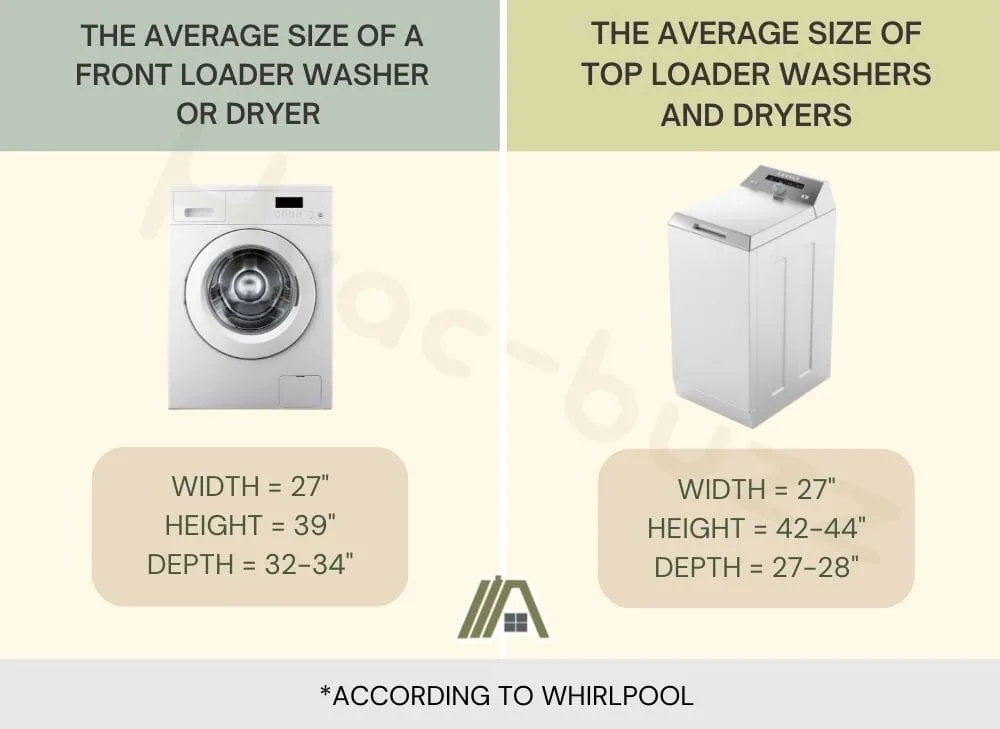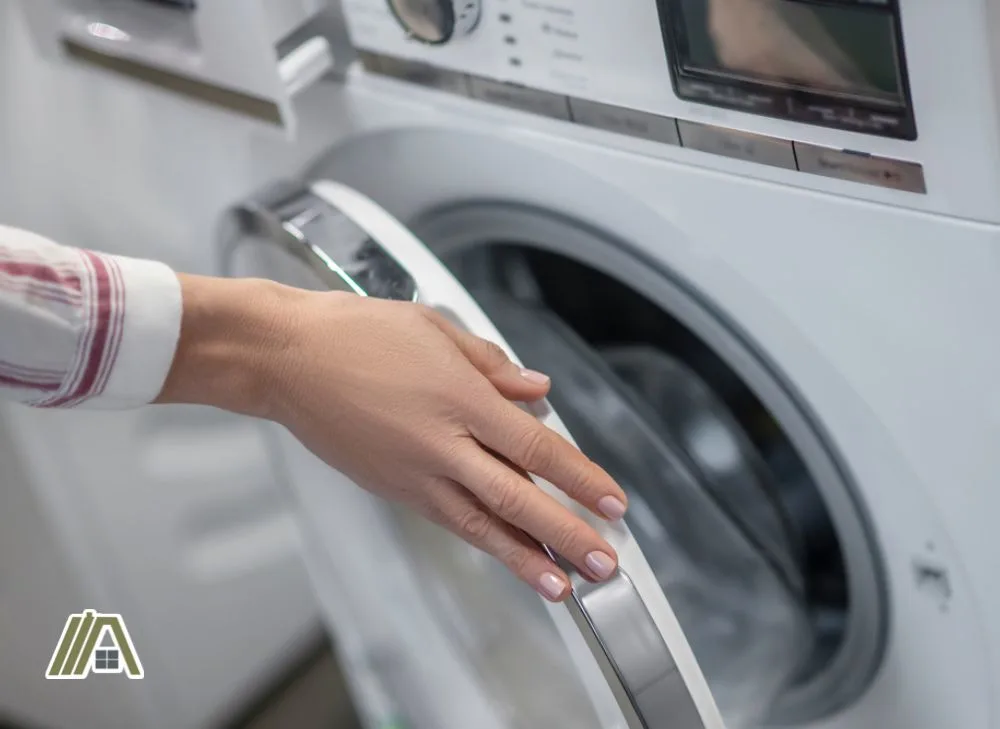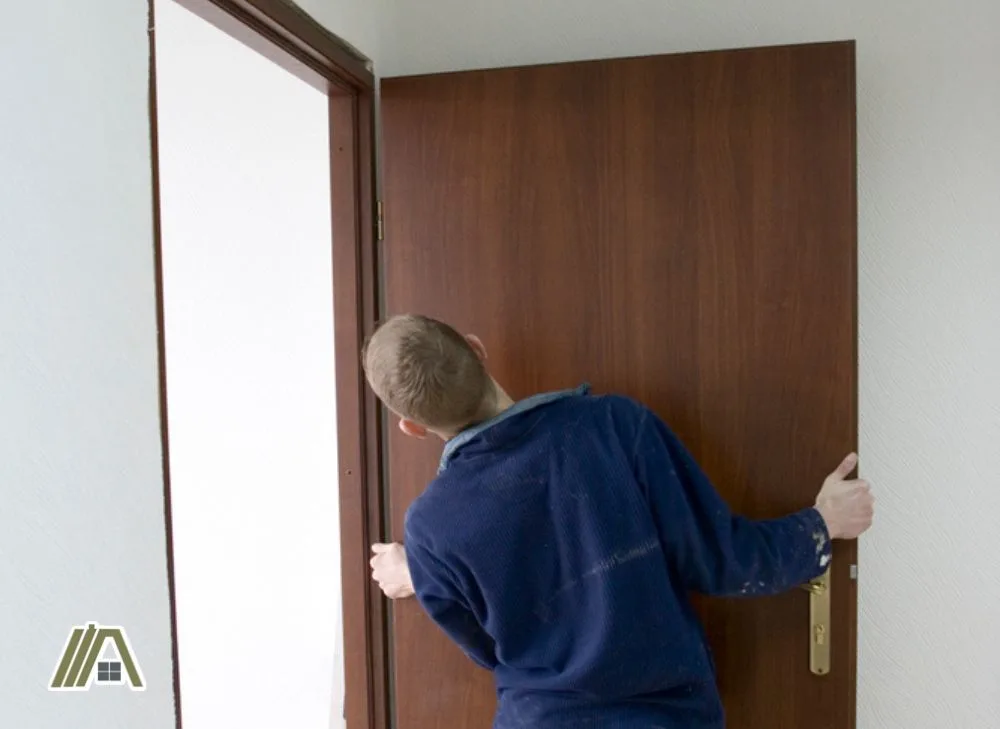There are certain seemingly insignificant moments in life that can bring you to tears. Now, I don’t mean to be dramatic, but for me, realizing that an appliance is not going to fit through a door is one of them. After all, you can’t suspend the laws of physics just to get the washer into the newly created laundry room.
All those “helpful” people telling you that you should have measured the washer beforehand only make things worse. Because I understand, there is no judgment here. This article is designed to be actually helpful now that you find yourself in this position.

Washers/dryers can be wider than they are deep, so try to swivel the appliance. Remove the front loader door. Water pipes, venting tubes, and power cables can be removed from the back. Combine these methods. Try the window. The doorway can be widened relatively easily and it can have additional benefits.
Average Washer/Dryer Size
According to Whirlpool, the average size of a front loader washer or dryer is:
- Width = 27″
- Height = 39″
- Depth = 32-34″
They give the average size of top loader washers and dryers as:
- Width = 27″
- Height = 42-44″
- Depth = 27-28″

If you are looking for some more information on this, we have put together a Washer/Dryer Sizing Guide (All Sizes Listed).
Average Door Size
The height of a door will always be enough to accommodate the washer or dryer; it’s the door width that’s going to be the issue. The average size of a door is about 30-32″ wide, but you can also get doors that are a mere 24″ wide!
If your door is 24-26″ wide, then you are likely not going to be getting that dryer through the door. If all you are missing is a couple of extra inches, then there are tips to try and make it work.
Tips to Get a Washer Dryer Through the Door
1. Swivel the Appliance
If it is too wide, can you swivel it to the side (top still up and bottom still down) so that you are dealing with the depth of the machine instead of its width?
As you can see from our average dimensions of washers and dryers, front loaders can have a smaller depth than width. Top loaders tend to be much of a muchness in these dimensions, but still, give it a try if you can.
2. Remove the Washer/Dryer Door
When trying to fit the washer or dryer through a comparatively narrow door, you might just be able to shave off the confounding inches on the washer or dryer by removing some parts that are designed to be removable.

On front loaders, you can take off the door. This tends to stick out quite a bit from the front panel and removing it can allow you to easily fit the appliance through the door.
You then refit the door when the washer or dryer is in place, and voila!
If this is an older appliance, removing the door is a great chance to give it a quick clean and an assessment. Do the hinges need replacement? What about the seals and gliders?
Most dryer doors are designed to be reversible, so rest assured that removing the doors is not going to be damaging. You might also want to take advantage of the chance to reverse the swing direction of the door if it would be more convenient.
3. Remove Other Parts that Stick Out
Head to the back of the washer or dryer and look at what can be removed there. Remove power cables, water pipes, venting tubes, etc. All of these things are designed to be removable.
Power cables often come separate to the machines, so obviously they are able to be unplugged from the back.
Dryer venting tubes have to be cleaned in order to remain safe and compliant, so they will be able to be unscrewed or pulled out and replaced with no hassle. Tip: clean them out before putting them back on the dryer.
Water pipes for ventless dryers and washers should also be able to twist off like hoses. Ventless dryers particularly only have a plumbing hose when the owner opts for one. The default is a collection tank, so the hose will definitely be detachable.
4. Remove the Door
The door frame may be wide enough but the door itself reduces the space between the frames (unless your door opens flat against the wall, although, even then, the hinges might be in the way).

If you take the door off of the frame, this could give you enough space the get the washer or dryer through the frame without any trouble (or only a little bit of finger pinching).
While the door is off the hinges, why not give it a new coat of paint? It’ll change the look of the room, even if you haven’t done any other remodeling.
You can also choose a bathroom paint that will withstand the humidity produced in the laundry room better than regular paint, preserving the fresh look of the paint job.
5. Put Them All Together
As you probably already guessed, while one of the above tips might not work, combining them all could be the key.
None of them are particularly difficult or time-consuming. So, even if you do all of them, you can have your washer or dryer in that room (or out of it) in a few hours. Yes, that’s longer than it would be to simply push the machine through the door, but we take what we can get if it means getting that machine where we want it.
6. Is it Too Wide for the Window?
If you cannot get the washer or dryer through the door, can you get it through the window? This is not a solution for everyone, even if the window is wide enough.
Second-floor rooms would introduce the issue of having to lift the appliance up so high (although I have been involved in pulling a couch up through a second-story window—ropes and a lot of manpower, in case you were wondering).
Windows may be wide enough in theory, but if they are crisscrossed with cottage pane framing, then this is not an option at all.
7. Increase the Door Width
Hear me out here because I know that expanding a doorframe is not the simplest solution. However, if your doorway is so small that none of the other methods worked, then not only is it your only remaining option, but it has other notable benefits as well.
Narrow doorways make carrying loads of laundry in and out very difficult. You only have to pinch your fingers between the laundry basket and the doorframe a few times before you’re ready to rip the door out anyway.
Wider doorways can help to ventilate the humidity-prone laundry room.
Finally, widening the doorway can make your home more attractive to sellers if you ever want to sell.
The buyer will have the same issue of appliances being too wide for the door. They might pick this up when they view the house and decide to keep looking.
There is also the possibility that your home may be purchased by someone in a wheelchair or with a walking aid. They will definitely be looking at doorway widths. You also never know what may happen, you may end up needing a walking device or someone who does may move in with you.
Here’s a great video showing you just how much easier you think extending your doorway will be.

